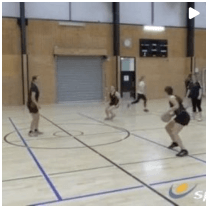Sagging defence system
Hi allIâve heard a lot about sagging defence... so how is this done and why? What progressive plan can you use. Thanks
Asked using Sportplan Mobile App





Hi Carie,
Sagging defence is also known as a zonal defence, this is whereby the defensive players drop back off their individual opponent and instead mark the space. The purpose of this is to make it harder for the ball carrier to see their options and also harder for the attackers to see the space to move into. This type of defence system can be extremely successful and force an error or a long ball which can be easily intercepted. However, each defensive player needs to do their role for the zone to be successful.
For attackers to break through the zone they must take the defence on. This will draw the defence out and allow another player to drive into the space created. Although the player who has taken on the defender may not receive the ball, they will have created space for their teammates to drive through. Alternatively, if the defender does not come with them, they will be free to receive the ball.
As an example, in the diagram attached you can see a diamond zoning defence has been set up. Once the ball has been passed to the WD the defending players (GS, GA, WA and C) have dropped back to form a zoning defence. As you can see they are not marking their individual players, but instead the space. Therefore if for example the GD tries to cut through the zone, the GD and GA can close them down. Likewise, if the attacking C tries to drive forward they will be closed down by the WA and C (if they went left).
You can find session plans focused around this type of defence in our `Plans` section, however it may be called `zoning` rather than sagging.
Hope this helps.
Hi Carie,
Sagging defence is also known as a zonal defence, this is whereby the defensive players drop back off their individual opponent and instead mark the space. The purpose of this is to make it harder for the ball carrier to see their options and also harder for the attackers to see the space to move into. This type of defence system can be extremely successful and force an error or a long ball which can be easily intercepted. However, each defensive player needs to do their role for the zone to be successful.
For attackers to break through the zone they must take the defence on. This will draw the defence out and allow another player to drive into the space created. Although the player who has taken on the defender may not receive the ball, they will have created space for their teammates to drive through. Alternatively, if the defender does not come with them, they will be free to receive the ball.
As an example, in the diagram attached you can see a diamond zoning defence has been set up. Once the ball has been passed to the WD the defending players (GS, GA, WA and C) have dropped back to form a zoning defence. As you can see they are not marking their individual players, but instead the space. Therefore if for example the GD tries to cut through the zone, the GD and GA can close them down. Likewise, if the attacking C tries to drive forward they will be closed down by the WA and C (if they went left).
You can find session plans focused around this type of defence in our `Plans` section, however it may be called `zoning` rather than sagging.
Hope this helps.

Diamond - backline zone
This drill has no description.
Diamond - backline zone
This drill has no description.















